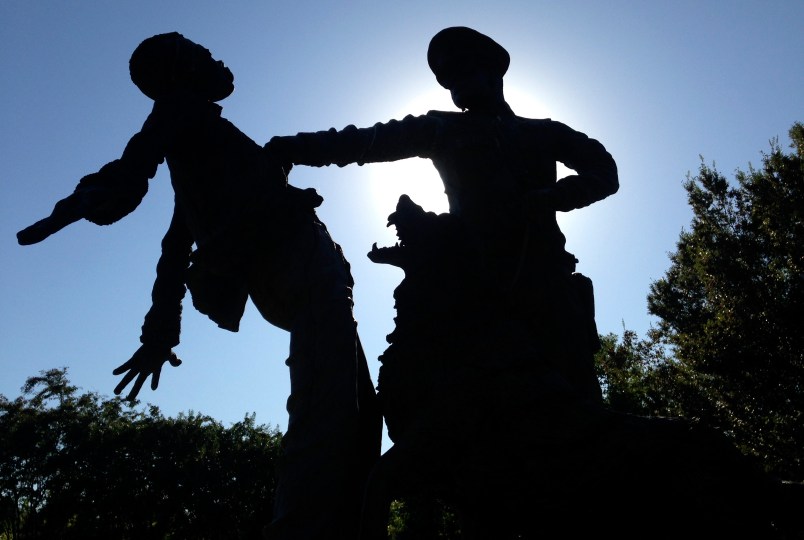ALBUQUERQUE, N.M. (AP) — A once-thriving all-black settlement in the New Mexico desert is a ghost town that rarely appears on maps. Tour buses pass but never stop at a Houston building where Latino activists planned civil rights events. Motels that welcomed minority motorists along 1950s Route 66 sit abandoned.
From a Civil War battlefield where Hispanic Union soldiers fought to birthplaces of civil rights leaders, sites linked to the nation’s struggle for racial equality are overlooked, neglected and absent from travel guides.
Some states like Alabama, once known for discrimination and violence, are making strides to preserve historic sites. Advocates say it’s time that more states and communities work to draw attention to the sites before they are lost to memory and time.
The efforts come amid a demographic shift that indicates the U.S. population will be majority-minority by mid-century, highlighting a need to cover all history.
“I think generally we need to be more inclusive,” said Rita Powdrell, president of the African American Museum & Cultural Center of New Mexico. “There are a lot of sites that should be recognized and remembered because they tell our story.”
In Albuquerque, for example, there are no detectable markers for black civil rights advocate and 1950 Nobel Peace Prize Ralph Bunche, who attended school in the city. There also are no historic makers for David C. Marcus, an Albuquerque High School graduate who represented Latinos in landmark desegregation cases in California, including Mendez v. Westminster that challenged Orange County’s segregated school system.
Though funds are limited, efforts are underway to save some sites.
In Houston, a nonprofit recently formed to restore a building that served as a meeting place for Latino civil rights groups during the 1950s, said Ray Valdez, president of the League of United Latin American Citizens’ LULAC Council 60.
It was there that Gus Garcia and other lawyers met to map out desegregation cases, and John J. Herrera planned a meeting with President John F. Kennedy the night before his assassination.
“Previous LULAC leaders left it in bad shape,” Valdez said. “They hadn’t paid property taxes on it for several years. They hadn’t kept maintenance on it for several years.”
The nonprofit hopes to use the building as a community center and museum on Mexican-American history, Valdez said.
Not all states and cities are letting time bury memories of civil rights sites. In Alabama, for example, tourism officials invite visitors to experience such places as the University of Alabama’s Foster Auditorium, where Gov. George Wallace stood at the entrance to prevent two black students from entering in 1963. The students were later allowed to enroll after President Kennedy placed the Alabama National Guide under federal control.
In nearby Birmingham, the city promotes a civil rights heritage trail. Visitors can see more than 70 sites of national merit designated by the National Register of Historic Places in Birmingham’s Civil Rights District. Among those sites are the 16th Street Baptist Church, where four black girls were killed in a bombing. Statues of civil rights marchers are at locations of critical demonstrations.
In Oakland, California, markers highlight locations connected to the Black Panther Party of the late 1960s.
City officials in Albuquerque are working on a revitalization plan for the De Anza Motor Lodge. The empty and fenced off building was one of the motels that offered lodging to black and Hispanic travelers along the famed Route 66 from Chicago to Los Angeles during segregation.
New Mexico’s Tourism Department promotes the state’s Hispanic and Native American heritage, encouraging people to visit Taos Pueblo or Santa Fe Plaza. But little is done to highlight Blackdom, an all-black frontier ghost town that advocates say could be a tourism attraction.
The state also doesn’t have a marker in the northern New Mexico ghost town of Dawson, the birthplace of United Farm Workers co-founder Dolores Huerta. Recently, the Albuquerque Public Schools named a school after pioneer Latino scholar George I. Sanchez, who was born in the city.
New Mexico Office of African American Affairs executive director Yvette Kaufman-Bell said it will take a community effort to bring attention to these sites, including creating simple informative, tourist brochures. “It’s up to us to tell our own history,” she said.
___
Follow Russell Contreras on Twitter at http://twitter.com/russcontreras . His work can be found at http://bigstory.ap.org/content/russell-contreras .
Copyright 2016 The Associated Press. All rights reserved. This material may not be published, broadcast, rewritten or redistributed.







Well that’s a bizarre way of phrasing that.
In fairness…
There are tons of “National Historic Sites” that are falling into disrepair or just flat being sold off beyond these.
Hell, every few months my Dad and Brother get both physical and email mailers about how another corner of the Gettysburg Battlefield was bulldozed to make a new strip mall, where I lived in North Carolina, one of the fields of a skirmish that was relatively important to the surrender of Jefferson Davis is literally a Wal*Mart.
and then there are the sites that are part of a larger site. Like the Motel mentioned… The people I know travel Route 66 to see ROUTE 66 (not to mention much of Route 66 itself has disappeared), they’re more interested in the Cadillacs that are upended and buried along the roadside then a “Historical Motel” (of which there are more than a few)
Historical sites are lost all the time. It has more to do with public indifference to Historical Sites in general than it does to the history there.